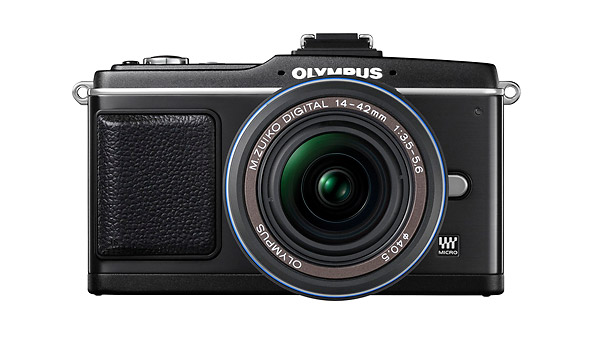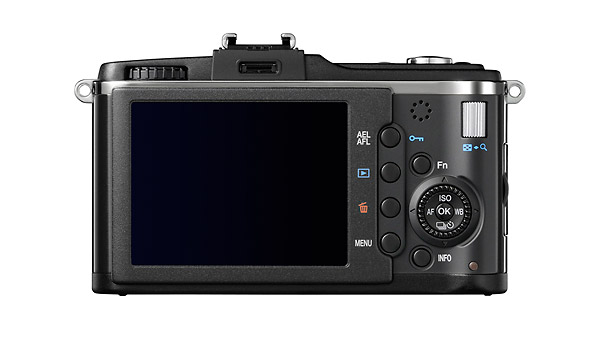Olympus E-P2 New Art Filters And Picture Mode
The E-P2′s software changes include new Diorama and Cross Process Art Filters and a new iEnhance Picture Mode. The Diorama Art Filter is basically an in-camera toy village/tilt-shift effect. For those of you who never had the opportunity to experiment with film, cross processing was when you processed slide film or color negative film in the wrong chemicals. I won’t try to describe the look but it was very popular with some fashion and fine art photographers a few years ago. Both the Diorama and Cross Process effects are worthy Art Filters and add to a fun set of sophisticated in-camera effects that Olympus introduced with the E-30.
The Olympus Picture Modes are a set of in-camera image quality parameters, including Vivid, Natural, Portrait, Custom – and now – iEnhance. The iEnhance Picture Mode “detects the dominant color in the scene and selectively increases the brightness/saturation wherever that color exists within the image…” The intent is to recreate the emotional feel of a scene rather than trying to be strictly accurately about color. I haven’t tested the new Picture Mode since I only had a pre-production camera. But since I almost always do some post-processing to match my emotional memory of a scene, I like the concept behind the iEnhance Picture Mode.
Olympus E-P2 Conclusion
I know a lot of people will be comparing the new Olympus E-P2 to Panasonic’s recently announced GF1 Micro Four Thirds camera. The main benefits of the GF1 are a built-in pop-up flash, higher-resolution LCD display and better auto focus. The main benefits of the E-P2 are built-in sensor-shift image stabilization, the included articulated EVF and the ability to use external microphones for video. The Olympus is also a better looking camera, although that’s really not a criterion we should be using when buying a camera. By most accounts and on paper, the Panasonic looks like a better camera – especially for photographers who really need responsive auto focus. The E-P2′s new auto focus tracking is neat and should offer real benefits, but it’s not a replacement for AF speed and accuracy and it’s very unlikely the focus be as good as the Panasonic GF1.
The E-P2 is a refined version of the E-P1. People who are expecting something brand new in terms of image quality or overall performance should probably wait or take a look at a digital SLR. If I already had an E-P1, I probably wouldn’t sell it to buy an E-P2. But for people who are on the fence about the Micro Four Thirds format and liked the E-P1 but weren’t ready to commit – the E-P2 looks to be a very capable compact camera. The EVF is a nice addition as is the option of using an external stereo microphone. The C-AF auto focus tracking is also a very nice new feature and should make the E-P2 better than the E-P1 for photographing or filming moving subjects.
The new Olympus E-P2 Micro Four Thirds camera will be available in December in a kit that includes either the ED 14-42mm f/3.5-5.6 Zuiko Digital zoom lens or the 17mm f/2.8 Zuiko Digital lens. Both kits come with the VF-2 Electronic View Finder and should sell for $1099.99.
Related Content:
All Olympus User Reviews
Olympus and Four Thirds Cameras Forum
More Olympus News, Reviews, and Articles
Olympus Cameras Web Site




That would be a tight camera for travel shooting.
-M
“Besides the EVF, the new Accessory Port will also accommodate an external microphone.”
Do you mean it will do both at the same time?
Or it’s one or the other?
“a focus box that follows the subject, once it’s locked.”
Just like the GH-1 already has, and if it’s as slow as the GH-1 it’ll be almost unusable for anything moving at speed.
I tried the GH-1 on birds in flight, and on cars – failure on both. The problem was mainly the time it takes to identify and lock on the target, with both by the time it’s locked the subject’s gone by.
The GH-1 works for an active cat (or maybe kittens) in a confined area, like running about the room in front of you, so I think it does what it’s intended.
I expect the E-P2 will have similar performance.
Maybe I shouldn’t have got the E-P1 immediately … this has most of the features I wanted that make up for the lack of a tilt/swivel screen on the GH-1.
Oh well there’s never a good time to buy a new camera, and early adopters always pay for it somehow – I know that.
Paul-
Thanks for asking about the Accessory Port. I asked Olympus the same question and forgot to inlcude that detail in the article. No, you can’t use the EVF and an external mic at the same time. You have to choose one or the other.
I still haven’t used the GH1 so I can’t comment on auto focus tracking with it. I also can’t comment on the performance of the E-P2 AF tracking since the camera I had was a pre-production unit. All I know is it seems pretty cool. However, based on my experience with the Panasonic G1 and the Olympus E-P1 and other reports on the Web, I don’t think any Micro Four Thirds camera is a suitable tool for action shooting. The auto focus systems just aren’t up to par when compared with even the lowliest digital SLR.
Pingback: Olympus E-P2 video | Fotografia e Web Marketing